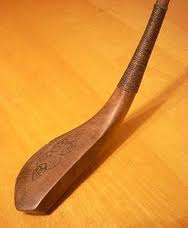Antique Appraisal: Golf Club Collecting
 Imagine! You are at a garage-sale rummaging through ‘stuff’ that seemingly has little or no appeal except to your scavenger instinct, and right before your eyes is an old wooden-headed golf club; painted black. Beneath the chipped paint and grime is the name Tommy Armour imprinted on the club’s head.
Imagine! You are at a garage-sale rummaging through ‘stuff’ that seemingly has little or no appeal except to your scavenger instinct, and right before your eyes is an old wooden-headed golf club; painted black. Beneath the chipped paint and grime is the name Tommy Armour imprinted on the club’s head.
“How much for this old beat-up club,” I ask, hoping the answer fits my budget. “Hmm, how about ten bucks,” replies the unknowing owner obviously with instructions by his wife to clean-it-out and clear-it-out at whatever the traffic will bear.
As a pseudo-collector, you recognize a find even when it smacks you in the face. You read somewhere that Armour, a well-known golfer of the 20s and 30s, had licensed the use of his name on certain quality clubs, and today knowledgeable golf equipment collectors consider them very desirable. It turns out that not only is the current market value of that club, when professionally refurbished, about $350.00, but also among enthusiasts and golf-purists many of those types of clubs can still be used in play.
That is how valuable some old golf clubs have become; and by old, I mean even antique. Some clubs made in the 1700s still exist, but the pre-1850 wooden-head clubs – all shafts and club heads for all clubs were wooden until the 1920’s – are the true antiques of golf. The most valuable were made in Scotland before 1850 by Hugh Philp. The Philp clubs are called long nose because their heads are uniquely about 5” along the face of the club and have Philp stamped on the club head; but beware, when he died someone stole his stamp and produced fakes.
As a collector, almost any pre-1850 club will have worthwhile market value. Here are some clues: a shallow face on a wood usually means early manufacture, as does a shaft made of ash. Hickory shafts didn’t hit the market until about 1840. Old irons can be spotted by looking closely at the hosel – the metal section that attaches the iron head to the wooden shaft. The club is pre-1850 if the hosel has a seam showing where it was hand-rolled into a cylinder-shape; after 1850, hosels were solid iron without a seam.
Another point to keep in mind is that age increases value; but how can you approximate the age of a club that perhaps has been ‘modernized’ with an obvious coat of ‘spit and polish’? Simple; check out how the head and the shaft are attached. In the 1800s, the joint was strengthened with 5 or 6 inches of ‘whipping’ – strong thread tightly wound around the joint and then shellacked or tarred; after about 1905, less whipping was used. You might also want to pay attention to the club face which in the 1800s was smooth; it was grooved later to give better control over shots.
CONTACT US with our online form or call (888) 353-7152 if you would like an antique golf club appraisal.
